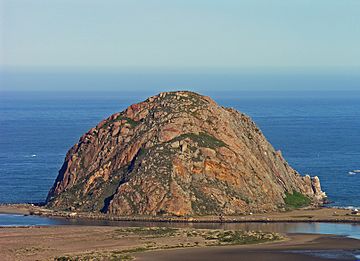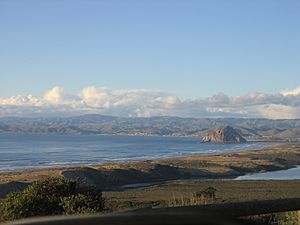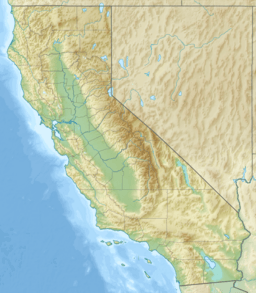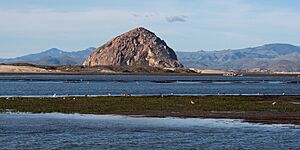Morro Rock facts for kids
Quick facts for kids Morro Rock |
|
|---|---|

Morro Rock looking west
|
|
| Highest point | |
| Elevation | 581 ft (177 m) NAVD 88 |
| Geography | |
| Parent range | Santa Lucia Range |
| Topo map | USGS Morro Bay South |
| Geology | |
| Age of rock | About 23 million years |
| Mountain type | Volcanic plug |
| Volcanic arc/belt | Nine Sisters |
| Designated: | January 1, 1968 |
| Reference #: | 821 |

Morro Rock is a famous landmark in Morro Bay, California. It sits right at the entrance to Morro Bay harbor on the Pacific Coast. This huge rock is actually a volcanic plug, which is like the leftover core of an ancient volcano.
A special road, called a causeway, connects Morro Rock to the shore. This makes it a "tied island," meaning it's an island connected to the mainland by a narrow strip of land. Morro Rock is a protected area, known as the Morro Rock State Preserve. The Salinan people call it Le'samo, and the Northern Chumash call it Lisamu.
Contents
What is Morro Rock Made Of?
A Volcanic Plug
Morro Rock stands about 581 feet (177 meters) tall. It is one of 13 large rock formations in San Luis Obispo County, California. These rocks are all volcanic plugs or lava domes. They are the hard centers of volcanoes that erupted millions of years ago. Over time, the softer parts of the volcanoes wore away, leaving these strong rock cores behind.
Rock Types in Morro Rock
Morro Rock is mostly made of a type of rock called dacite. Dacite is an igneous rock, which means it formed from cooled lava. It contains minerals like plagioclase, amphibole, and quartz. Some parts of the rock also have petrified (turned to stone) bird droppings mixed in.
How Old is Morro Rock?
The rocks that make up Morro Rock are very old. They formed about 23 million years ago during a time called the Oligocene epoch. These rocks are part of a larger group called the Mono Rock-Islay Hill Complex. Scientists have studied these rocks to learn about how the land has changed over millions of years.
History of Morro Rock
Native American History
Both the Salinan and Chumash tribes consider Morro Rock a very special and sacred place. The Chumash had an important village near Morro Creek, close to where Morro Bay High School is today. This village existed as far back as 6500 B.C.E.
The Salinan people have a right to climb Morro Rock for their special ceremonies twice a year. They celebrate a legend where a hawk and a raven defeated a monster wrapped around the rock. The Chumash tribe also believes the rock is sacred, but they feel it should never be climbed. Because the rock is fragile and important for wildlife, it is illegal for the general public to climb it.
European Discovery
Spanish explorers likely saw Morro Rock as early as 1542. However, it got its current name during the first European land exploration of Alta California. In 1769, the Spanish Portolá expedition camped near Morro Bay. A missionary with the group, Juan Crespí, wrote in his diary that they saw "a great rock in the form of a round morro." "Morro" is a Spanish word for a round hill or headland.
Quarrying and Protection
For many years, from 1889 to 1969, parts of Morro Rock were quarried. This means pieces of the rock were removed and used to build things like the breakwater in Morro Bay and improvements at Port San Luis Harbor.
In 1966, a state law was passed that gave ownership of Morro Rock to the State of California. In 1968, local groups successfully had Morro Rock declared a California Historical Landmark. This helps protect the rock for future generations.
Animals and Plants at Morro Rock
Birds and Marine Life
Morro Rock is a home for many birds. Several types of cormorants and gulls build their nests there. It is also a very important reserve for peregrine falcons. These falcons were once endangered in the area, and laws protect them and other birds on the rock.
In the waters around Morro Rock, you can often see sea lions and sea otters. Seals are more common in the nearby Morro Bay State Park, where they have their babies.
Tide Pool Creatures
When the tide is low, you can find many interesting animals in the tide pools around the rock. These include hermit crabs, small fish, starfish, sea cucumbers, and mussels.
Plants Around the Rock
The top of Morro Rock is a tough place for plants to grow because it's dry and windy. But in the bay nearby, you can find kelp, sea grass, and other plants that live in kelp forests and tide pools. On the rock itself, some common grasses, mosses, lichens, and weeds manage to take root.
Protected Ocean Areas
The waters offshore from Morro Bay are protected areas. These include the Morro Bay State Marine Recreational Management Area and Morro Bay State Marine Reserve. Think of them like underwater parks. They help protect ocean wildlife and the amazing marine ecosystems that live there.




